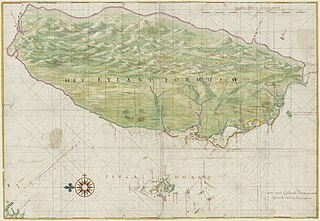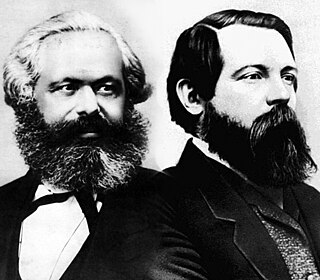Related Research Articles

Physiocracy is an economic theory developed by a group of 18th-century Age of Enlightenment French economists who believed that the wealth of nations derived solely from the value of "land agriculture" or "land development" and that agricultural products should be highly priced. Their theories originated in France and were most popular during the second half of the 18th century. Physiocracy became one of the first well-developed theories of economics.
Full employment is a situation in which there is no cyclical or deficient-demand unemployment. Full employment does not entail the disappearance of all unemployment, as other kinds of unemployment, namely structural and frictional, may remain. For instance, workers who are "between jobs" for short periods of time as they search for better employment are not counted against full employment, as such unemployment is frictional rather than cyclical. An economy with full employment might also have unemployment or underemployment where part-time workers cannot find jobs appropriate to their skill level, as such unemployment is considered structural rather than cyclical. Full employment marks the point past which expansionary fiscal and/or monetary policy cannot reduce unemployment any further without causing inflation.
The high-level equilibrium trap is a concept developed by environmental historian Mark Elvin to explain why China never underwent an indigenous Industrial Revolution despite its wealth, stability, and high level of scientific achievement. Essentially, he claims that the Chinese pre-industrial economy had reached an equilibrium point where supply and demand were well-balanced. Late imperial production methods and trade networks were so efficient and labor was so cheap that investment in capital to improve efficiency would not be profitable.

Sir William Arthur Lewis was a Saint Lucian economist and the James Madison Professor of Political Economy at Princeton University. Lewis was known for his contributions in the field of economic development. In 1979, he was awarded the Nobel Memorial Prize in Economic Sciences.
The Stolper–Samuelson theorem is a basic theorem in Heckscher–Ohlin trade theory. It describes the relationship between relative prices of output and relative factor rewards—specifically, real wages and real returns to capital.
A dual economy is the existence of two separate economic sectors within one country, divided by different levels of development, technology, and different patterns of demand. The concept was originally created by Julius Herman Boeke to describe the coexistence of modern and traditional economic sectors in a colonial economy.

The labor force in Japan numbered 65.9 million people in 2010, which was 59.6% of the population of 15 years old and older, and amongst them, 62.57 million people were employed, whereas 3.34 million people were unemployed which made the unemployment rate 5.1%. The structure of Japan's labor market experienced gradual change in the late 1980s and continued this trend throughout the 1990s. The structure of the labor market is affected by: 1) shrinking population, 2) replacement of postwar baby boom generation, 3) increasing numbers of women in the labor force, and 4) workers' rising education level. Also, increase in numbers of foreign nationals in the labor force is foreseen.
The dual-sector model is a model in development economics. It is commonly known as the Lewis model after its inventor W. Arthur Lewis. It explains the growth of a developing economy in terms of a labour transition between two sectors, the capitalist sector and the subsistence sector.

Baumol's cost disease, also known as the Baumol effect, is the rise of wages in jobs that have experienced little or no increase in labor productivity, in response to rising salaries in other jobs that have experienced higher productivity growth. The phenomenon was described by William J. Baumol and William G. Bowen in the 1960s and is an example of cross elasticity of demand.
The Habakkuk thesis, proposed and named after British economist Sir John Habakkuk, is a theory that land abundance and labor scarcity in antebellum America led to high wages, which resulted in effective searches for labor-saving technological innovations. This stimulated the growth of machinery and the development of the American system of manufacturing. Initially published in Habakkuk's 1962 work, American and British Technology in the Nineteenth Century: The Search for Labor-Saving Inventions, the thesis garnered attention as the classical interpretation and explanation of American industrialization. The thesis has been criticized for leaving out high interest rates, lack of machinery as capital and scarce and expensive factors.
In international economics, international factor movements are movements of labor, capital, and other factors of production between countries. International factor movements occur in three ways: immigration/emigration, capital transfers through international borrowing and lending, and foreign direct investment. International factor movements also raise political and social issues not present in trade in goods and services. Nations frequently restrict immigration, capital flows, and foreign direct investment.
Low-cost country sourcing (LCCS) is procurement strategy in which a company sources materials from countries with lower labour and production costs in order to cut operating expenses. LCCS falls under a broad category of procurement efforts called global sourcing.

Tshilidzi Marwala is a South African artificial intelligence engineer, a computer scientist and a mechanical engineer.

In China today, poverty refers mainly to the rural poor, decades of economic development has reduced urban extreme poverty. According to the World Bank, more than 850 million Chinese people have been lifted out of extreme poverty; China's poverty rate fell from 88 percent in 1981 to 0.7 percent in 2015, as measured by the percentage of people living on the equivalent of US$1.90 or less per day in 2011 purchasing price parity terms,which still stands for 2022.Chinese definition of extreme poverty is more stringent than that of World Bank, and is defined as earning less than $2.30 a day at purchasing power parity (PPP),Since the start of far-reaching economic reforms in the late 1970s, growth has fueled a substantial increase in per-capita income lifting people out of extreme poverty. China's per capita income has increased fivefold between 1990 and 2000, from $200 to $1,000. Between 2000 and 2010, per capita income also rose by the same rate, from $1,000 to $5,000, moving China into the ranks of middle-income countries. Between 1990 and 2005, China's progress accounted for more than three-quarters of global poverty reduction and a big factor in why the world reached the UN millennium development of dividing extreme poverty by two. This can be attributed to a combination of a rapidly expanding labour market, driven by a protracted period of economic growth, and a series of government transfers such as an urban subsidy, and the introduction of a rural pension. The World Bank Group suggests that the percentage of the population living below the international poverty line of $1.9 fall to 0.7 percent in 2015, and poverty line of $3.2 to 7% in 2015.At the end of 2018, the number of people living below China's national poverty line of ¥2,300 (CNY) per year was 16.6 million, which translated to 1.7% of the population at the time.

"Dirty, dangerous and demeaning", also known as the 3Ds, is an American neologism derived from the Asian concept, and refers to certain kinds of labor often performed by unionized blue-collar workers.

The recordkeeping and development of the economic history of Taiwan started in the Age of Discovery. In the 17th century, the Europeans realized that Taiwan is located on the strategic cusp between the Far East and Southeast Asia. Two main European empires that competed to colonize it were the Dutch and Spanish Empires. Taiwan also became an intermediate destination for trade between Western European empires and East Asia states. The history of Taiwan as a colony of the Dutch Empire, Kingdom of Tungning, Qing China, and Empire of Japan between 1630 and 1945 was based heavily on economics.
The East Asian model pioneered by Japan, is a plan for economic growth whereby the government invests in certain sectors of the economy in order to stimulate the growth of specific industries in the private sector. It generally refers to the model of development pursued in East Asian economies such as Japan, South Korea and Taiwan. It has also been used by some to describe the contemporary economic system in Mainland China after Deng Xiaoping's economic reforms during the late 1970s and the current economic system of Vietnam after its Doi Moi policy was implemented in 1986.
The Fei–Ranis model of economic growth is a dualism model in developmental economics or welfare economics that has been developed by John C. H. Fei and Gustav Ranis and can be understood as an extension of the Lewis model. It is also known as the Surplus Labor model. It recognizes the presence of a dual economy comprising both the modern and the primitive sector and takes the economic situation of unemployment and underemployment of resources into account, unlike many other growth models that consider underdeveloped countries to be homogenous in nature. According to this theory, the primitive sector consists of the existing agricultural sector in the economy, and the modern sector is the rapidly emerging but small industrial sector. Both the sectors co-exist in the economy, wherein lies the crux of the development problem. Development can be brought about only by a complete shift in the focal point of progress from the agricultural to the industrial economy, such that there is augmentation of industrial output. This is done by transfer of labor from the agricultural sector to the industrial one, showing that underdeveloped countries do not suffer from constraints of labor supply. At the same time, growth in the agricultural sector must not be negligible and its output should be sufficient to support the whole economy with food and raw materials. Like in the Harrod–Domar model, saving and investment become the driving forces when it comes to economic development of underdeveloped countries.

In Marxist theory and Marxian economics, the immiseration thesis, also referred to as emiseration thesis, is derived from Karl Marx's analysis of economic development in capitalism, implying that the nature of capitalist production stabilizes real wages, reducing wage growth relative to total value creation in the economy, leading to the increasing power of capital in society.
Engels' pause is a term coined by economic historian Robert C. Allen to describe the period from 1790 to 1840, when British working-class wages stagnated and per-capita gross domestic product expanded rapidly during a technological upheaval. Allen named the period after German philosopher Friedrich Engels, who describes it in The Condition of the Working Class in England. Economists have analyzed its causes and effects since the nineteenth century, with some questioning its existence. Twenty-first-century technological upheaval and wage stagnation have led economists and academics to draw parallels between the two periods.
References
- 1 2 3 Ranis, Gustav (August 2004). "Arthur Lewis' contribution to development thinking and policy" (PDF). www.yale.edu. Yale University . Retrieved 15 January 2015.
- ↑ Dammon Loyalka, Michelle. "Chinese Labor, Cheap No More". The New York Times . Retrieved 16 January 2015.
- ↑ Zhang, Xiaobo; Yang, Jin; Wang, Shenglin (December 2011). "China has reached the Lewis turning point". China Economic Review . 22 (4): 542–554. doi:10.1016/j.chieco.2011.07.002.
- ↑ Minami, Ryoshin; Ma, Xinxin (23 September 2010). "The Lewis turning point of Chinese economy: Comparison with Japanese experience". China Economic Journal. 3 (2): 163–179. doi:10.1080/17538963.2010.511912. S2CID 153570002.
- ↑ Das, Mitali; N'Diaye, Papa M. (2013). "Chronicle of a Decline Foretold: Has China Reached the Lewis Turning Point?" (PDF). IMF Working Papers. 13 (26): 1. doi:10.5089/9781475548242.001. S2CID 53959415.
- ↑ Marwala, Tshilidzi; Hurwitz, Evan (2017). Artificial Intelligence and Economic Theory: Skynet in the Market. London: Springer. ISBN 978-3-319-66104-9.